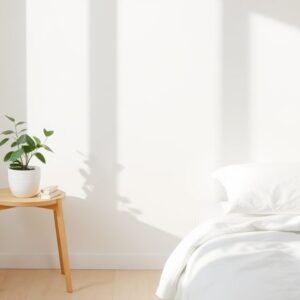If you're finding it tough to keep your small space tidy, you're definitely not alone. A lot of people face the same struggle when it comes to managing clutter in limited areas.
Fortunately, there are practical strategies you can use to take back control of your environment. For instance, consider adopting the one-in-one-out rule, where for every new item you bring into your home, you let go of an old one. This approach not only helps reduce clutter but also encourages mindful purchasing.
Additionally, making the most of vertical storage can work wonders in small spaces. Think about using wall-mounted shelves or tall bookcases to draw the eye upward, freeing up valuable floor space.
You might also want to invest in multifunctional furniture, like a coffee table with hidden storage or an ottoman that doubles as a seat and a place to stash blankets.
These small changes can significantly enhance the functionality of your home and create a more peaceful atmosphere. The key is to start somewhere—maybe begin by decluttering one area, like a closet or a corner of your living room.
What's one space you can tackle today?
Key Takeaways
Here are some effective tips for decluttering small spaces that can help you make the most of what you have:
First, think about using vertical storage solutions. Floating shelves and wall-mounted racks are fantastic options for keeping items off the floor and utilizing wall space. For example, a set of floating shelves in your living room can display books, plants, or decorative items, while also providing a neat way to organize your belongings.
Next, you might want to adopt the one-in-one-out rule. This means that whenever you bring a new item into your space, you should let go of an old one. This practice not only helps keep clutter at bay but also encourages you to be more mindful about your purchases. For instance, if you buy a new pair of shoes, consider donating an older pair that you no longer wear.
Sorting your belongings into categories can also be a game changer for organization. You can create three groups: items you use daily, those you need occasionally, and stuff you can part with. This helps you see what you truly need and allows you to keep only those items that serve a purpose or bring you joy.
Keeping surfaces clear is another smart strategy. It's easy for clutter to accumulate on countertops and tables, so try to minimize decorative items and store functional items out of sight. For example, instead of leaving mail piled up on the kitchen counter, use a stylish basket or box to keep it organized and out of view.
Finally, make it a habit to regularly evaluate your belongings. Set aside time every few months to go through your things and see what you no longer use or need. Consider donating or selling these items, which not only helps you maintain a tidy space but also benefits others. For instance, you could use platforms like Facebook Marketplace or local thrift stores to find new homes for your unused items.
By incorporating these tips into your routine, you can create a more organized and inviting living space, even in small areas.
Assess Your Space
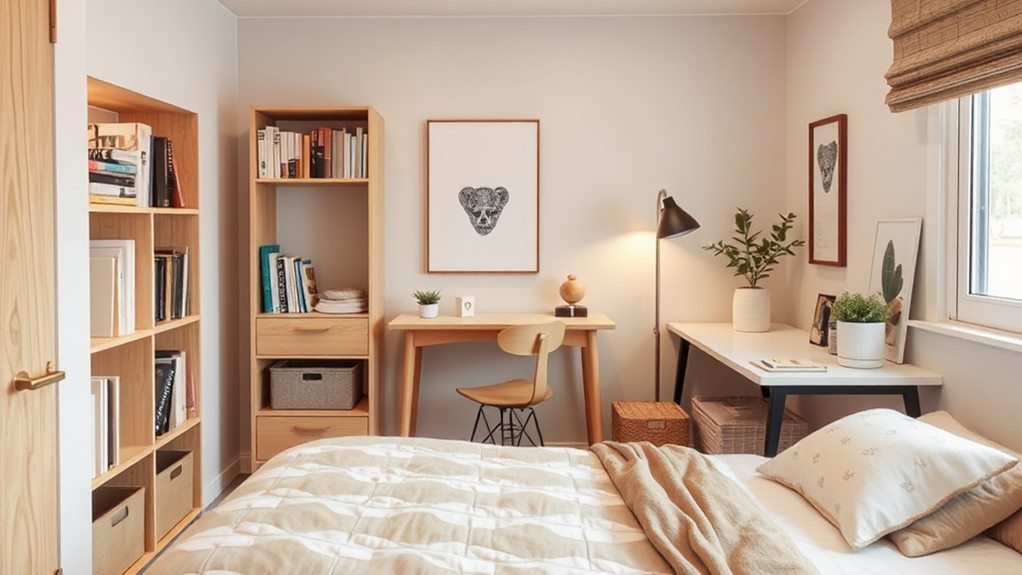
Before you jump into decluttering, take a moment to really look at your space. Start by walking through each room and asking yourself what items you genuinely use and need.
Pay attention to areas that feel crowded or disorganized; this awareness can give you insight into how your current setup impacts your daily life.
Consider what each room is meant to do. Is it functioning the way you want it to? If you find that it's not, think about how you might rearrange furniture or shift items around to make better use of the space you have.
It can be helpful to jot down a list of things that don't belong in each room, as this will make your decluttering process smoother.
While you're assessing your space, take some measurements of key areas. Knowing the dimensions of your rooms can really help you picture what'll fit and what won't.
A well-organized room layout not only makes the best use of your space but also enhances how you move through and enjoy your home.
For example, if your living room feels cramped, maybe it's time to swap out a bulky coffee table for a more streamlined option, like a nesting table set.
This small change can create a more open feeling and make it easier to navigate the room.
Embrace the One-In-One-Out Rule
Once you've taken a good look at your space and figured out what truly belongs in each room, it's time to get practical about keeping things tidy. Adopting the one-in-one-out rule can really make a difference, especially in small spaces. This approach encourages you to think carefully about your belongings and helps you embrace a simpler lifestyle.
Whenever you bring something new into your home, make it a point to let go of something else. This practice not only helps you consider whether your new purchase is genuinely useful but also keeps clutter at bay. For example, if you buy a new sweater, think about donating an old one that you haven't worn in ages. By managing your possessions this way, you create a more organized environment.
To make this rule work for you, start by jotting down items you're ready to part with. You might discover you have duplicates or items collecting dust. When you decide to make a new purchase, refer to your list and pick something to donate, recycle, or toss.
This strategy not only helps keep your space neat but also ensures that everything you own serves a purpose. In the end, embracing the one-in-one-out rule is a simple yet effective way to maintain order in your home while encouraging a more thoughtful relationship with your belongings.
Utilize Vertical Storage Solutions
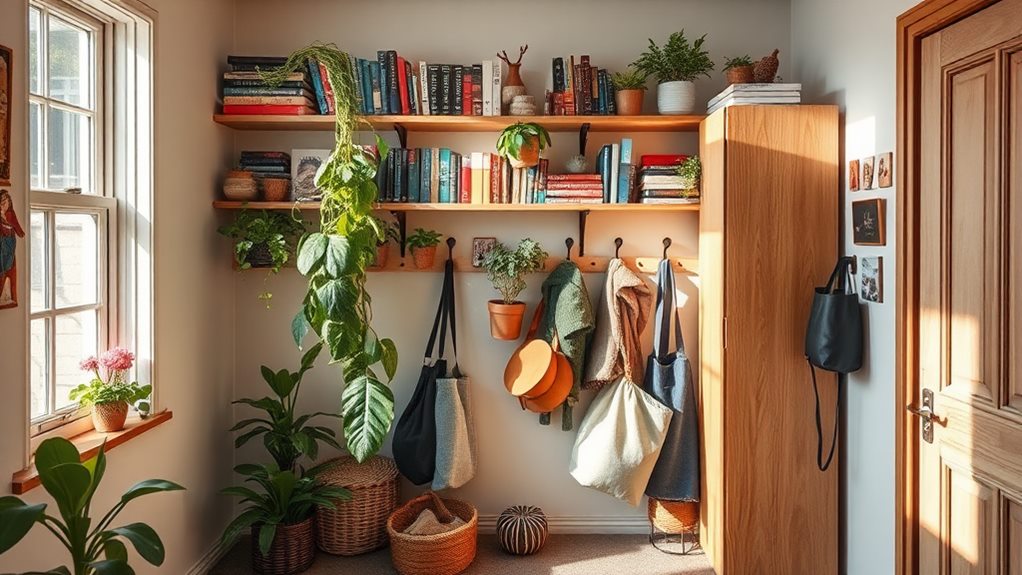
To make the most of your living space, consider embracing vertical storage solutions that utilize your walls. This method not only opens up your floor area but also helps keep your belongings organized and easy to find. For a start, think about installing floating shelves. They're perfect for displaying books or decorative items without cluttering your surfaces. If you need a spot for kitchen utensils or tools, wall-mounted racks are a great option. Plus, hanging organizers can tidy up small items in any room, making everything more accessible.
Another fantastic idea is to use pegboard systems. These are highly customizable and can be a game-changer for organizing craft supplies or garage tools. If you have larger items that need a home, consider ceiling storage. It makes great use of those often-forgotten spaces overhead. Ladder shelves not only provide multiple levels of storage but also add a stylish touch for displaying plants or books.
Here's a quick look at some effective vertical storage solutions and their benefits:
| Storage Solution | Benefits |
|---|---|
| Wall Mounted Racks | Versatile and sturdy for various uses |
| Hanging Organizers | Perfect for keeping small items organized |
| Pegboard Systems | Customizable and simple to set up |
| Ceiling Storage | Great for storing bulky items out of sight |
| Over the Door Hooks | Excellent for maximizing door space |
Implementing these solutions can truly transform your space into a more organized and spacious environment. Give them a try and see how much more efficient your home can become!
Invest in Multi-Functional Furniture
To make the most of your small space, investing in multi-functional furniture is key. These pieces not only save room but also enhance your decor.
For example, a sofa bed is a fantastic option for your living room. It offers a comfy place to relax during the day and quickly transforms into a cozy bed for overnight guests.
Another great choice is an ottoman with storage. This handy piece can double as extra seating while discreetly hiding away blankets and magazines, keeping your space tidy and stylish.
Consider a dining table that serves as a workspace, too. Look for a foldable or extendable design that can easily adapt to your needs, whether you're enjoying a small dinner or tackling some work projects.
Nesting tables are also a smart addition; they can be spread out when you need them or tucked away when you're short on space.
By choosing furniture that serves multiple purposes, you can maximize your area without making it feel cluttered. This not only helps keep things organized but also makes your home feel more inviting and spacious.
Create a Decluttering Schedule
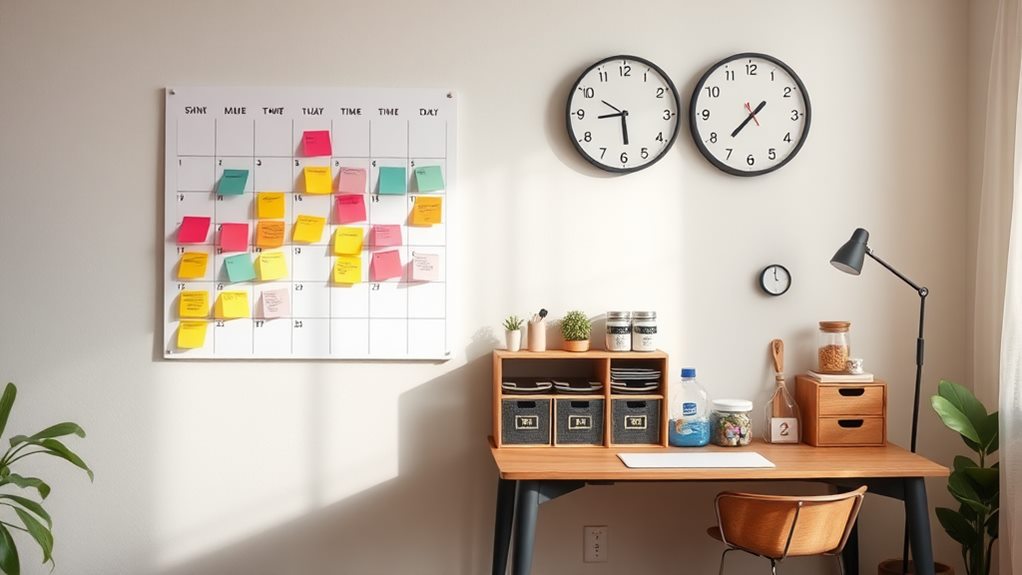
A well-organized decluttering schedule can really make a difference in turning your small space into a more inviting and functional area.
Adopting a decluttering mindset is key, and having a clear plan can help you tackle the mess without feeling overwhelmed.
To get started, break your decluttering tasks into manageable chunks. Here's a straightforward three-step schedule you can use:
1. Set Aside Time: Pick specific times each week to focus on decluttering. Even carving out just 15 to 30 minutes can lead to noticeable improvements over time.
Think about setting a timer to keep yourself focused and motivated.
2. Focus on One Area: Instead of trying to declutter your entire home in one go, zoom in on one small area at a time.
For instance, you might start with a single kitchen drawer or a shelf in your closet. This approach makes the task feel less daunting and allows you to see progress quickly.
3. Reflect and Revise: At the end of each week, take a moment to look back on what you've accomplished.
If you find that you're consistently hitting your targets, feel free to add more areas to your schedule. For example, if you've cleared out your kitchen drawer, you could move on to the next shelf or even tackle a bathroom cabinet.
Remember, the goal isn't just to declutter, but to create a space that feels more organized and peaceful.
Categorize Your Belongings
Decluttering can feel a bit daunting, but breaking it down into categories can make it a whole lot easier. Start by sorting your things into three key groups: items you use every day, things you need from time to time, and items you can let go of. This simple approach helps you see what's truly important in your life.
Once you've sorted everything, think about how to label your categories. Use boxes, bins, or shelves and stick labels on them. This way, you'll always know where your stuff belongs, and finding things later will be a breeze. For instance, you could have labels like "Daily Necessities," "Seasonal Gear," and "Cherished Memories."
As you organize, keep your space in mind. If you're working with a small area, consider using stackable containers or furniture that serves multiple purposes. This can help you save space while keeping everything tidy.
It's also a good idea to revisit your categories from time to time. What felt essential a few months ago mightn't have the same significance now, and that's perfectly okay. Regularly updating your labels will help you maintain a clutter-free environment.
Optimize Closet Organization
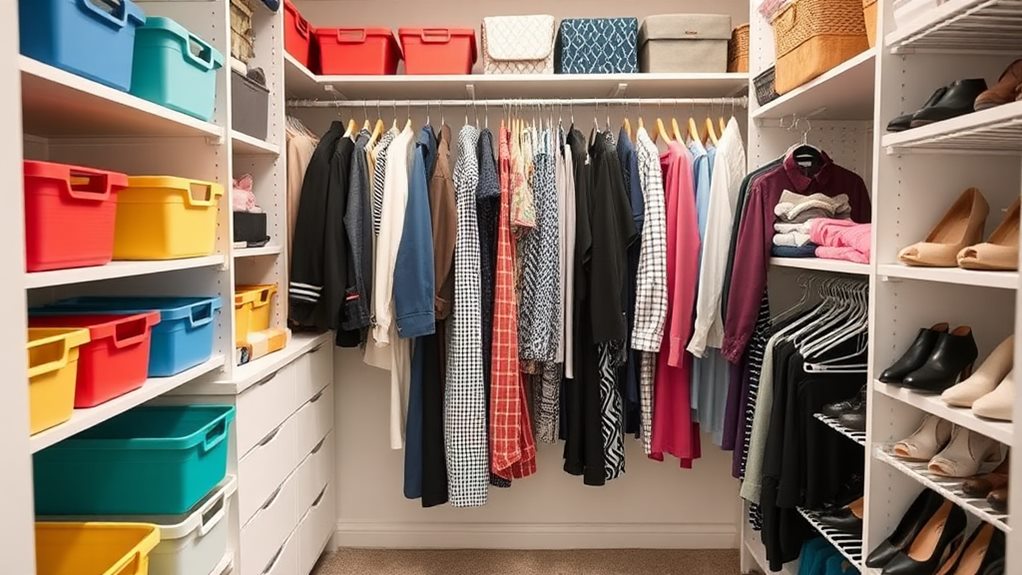
To make the most of your closet space, begin by taking advantage of vertical space. Adding shelves or hanging organizers can really help you maximize what you have. Think about it: when you use the height of your closet, you create more room for your belongings and keep everything within reach.
After that, take some time to sort through your items. Group similar pieces together—like your shoes, bags, or seasonal clothing. This organization makes it much easier to find what you need without rummaging through a mess.
Another helpful tip is to implement a seasonal rotation strategy. This means putting away clothes that are out of season and bringing forward what you'll be wearing soon. For instance, when winter ends, store away those bulky sweaters and pull out your lighter spring wardrobe.
Not only does this keep your closet looking tidy, but it also ensures that you're always ready for whatever the weather throws at you. Remember, a well-organized closet not only saves time but also helps you feel more at ease in your space.
Utilize Vertical Space
Making the most of the vertical space in your closet can completely change it from a chaotic jumble into a neatly organized area. When you take advantage of the full height of your closet, you open up more room for all your items. Here are some practical tips to help you achieve that:
First, consider installing wall-mounted shelves. These shelves help you utilize the upper parts of your closet, which is often wasted space. They're perfect for storing items that you don't need on a daily basis, like seasonal clothes or extra linens.
For example, you might place your winter coats or holiday decorations up there, freeing up lower areas for things you use more frequently.
Next, think about adding hanging organizers. These can be attached to the inside of your closet doors or along the sides. They're great for holding accessories, shoes, or smaller items, making everything easily visible and accessible.
You might find a hanging shoe organizer particularly useful, as it allows you to see all your shoes at a glance without taking up valuable floor space.
Lastly, incorporate vertical bins or baskets into your closet design. Look for stackable options that can help you make the most of the height available.
Labeling these bins can save you time and effort when you're looking for specific items. For instance, a set of labeled baskets for belts, scarves, or even off-season clothes can keep everything tidy while maximizing your storage capacity.
Sorting and Categorizing
Once you've optimized your vertical space, the next important step is to sort and categorize your items. This structured method not only makes everything easier to find but also saves you valuable time when you need to grab something quickly.
Start by grouping similar items together. Think about organizing based on their type, how often you use them, or even by color if that suits your style. For instance, you might keep all your winter clothes in one section and summer clothes in another. Once everything is sorted, consider adding labels to each category. Labels help you locate what you need at a glance and can be simple like sticky notes, or more elaborate like printed tags, depending on what you prefer!
Here's a handy reference table to assist you in the sorting process:
| Category | Grouping Method |
|---|---|
| Clothing | By season or type |
| Shoes | By occasion |
| Accessories | By type or color |
| Seasonal Items | By holiday or purpose |
Organizing your items this way can greatly enhance the functionality of your space. The goal is to create an environment that not only looks appealing but also meets your daily needs effortlessly. Happy organizing!
Seasonal Rotation Strategy
A seasonal rotation strategy is a great way to keep your closet organized and make the most of your space. By swapping out clothes according to the season, you can easily find what you need and enjoy a more functional wardrobe. Here's a simple guide to help you get started:
1. Sort Your Wardrobe: Begin by dividing your clothes into seasonal groups—think spring/summer versus fall/winter. By keeping only the items that match the current season within easy reach, you'll save time when getting dressed and reduce clutter.
2. Utilize Seasonal Storage: Consider getting some clear bins or vacuum-sealed bags to store off-season clothing. Clear bins allow you to quickly see what's inside, while vacuum-sealed bags save space by compressing your clothes.
Don't forget to label each container for easy access, and find a suitable spot for them—either in your closet or under the bed works well.
3. Plan Your Clothing Rotation: At the end of each season, take a moment to evaluate your wardrobe. This is your chance to donate or toss any pieces you haven't worn in the past year.
When you bring out your stored clothes, rotate in only the items you truly love and wear. For instance, if you find that you have three black sweaters but only wear one, consider donating the other two. This not only makes space but also ensures that your wardrobe is filled with items you enjoy.
Keep Surfaces Clear
Creating a sense of spaciousness in small areas can be as simple as keeping surfaces clear. Start by taking a good look at your countertops, tables, and shelves. When it comes to displaying items, aim for a more organized approach. Instead of crowding these spaces with too many decorations, consider using minimal decor that reflects your personality without making the area feel cramped.
For instance, a single, vibrant plant or a striking piece of artwork can add character and become a focal point. When it comes to functional items like kitchen appliances or books, think about storing them away when they're not in use. This helps keep your surfaces looking tidy and inviting.
To keep your space clutter-free, it's helpful to establish a daily tidying routine. Just a few minutes each day can make a big difference. As you do this, ask yourself whether items really need to be out or if they can find a home elsewhere.
Investing in stylish storage solutions can also enhance your decor while keeping things organized. Consider using decorative baskets or chic boxes that blend seamlessly with your design. These not only help you store necessary items but also contribute to a clean, attractive aesthetic.
Donate or Sell Unused Items
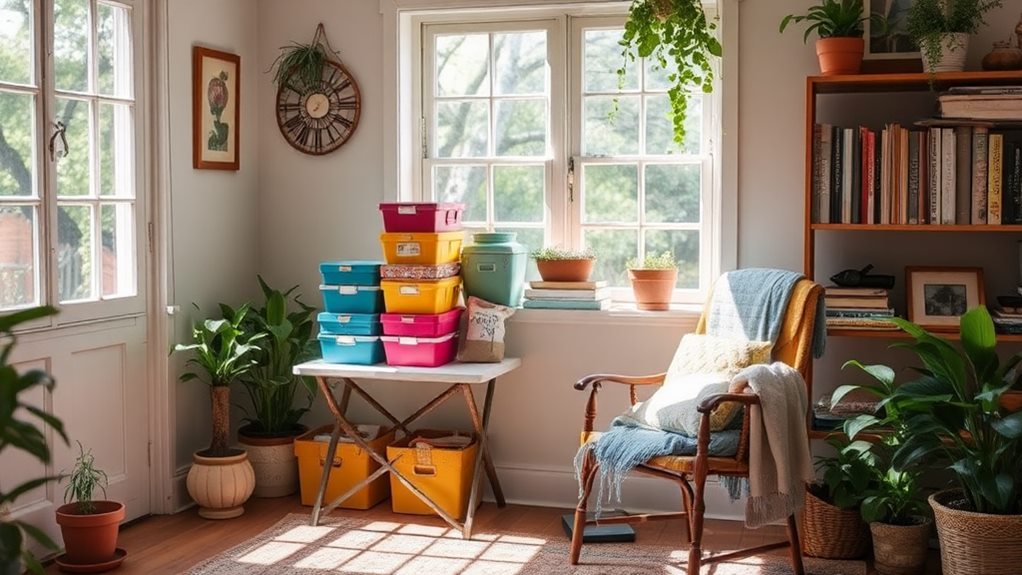
Keeping your surfaces clear not only makes your space feel more open but also gives you a chance to evaluate what you really need around you. After spotting those items you haven't used in a while, it's time to make a choice: should you donate them or try to sell? Both paths can help you reclaim space while either supporting someone in need or putting a little extra cash in your pocket.
Here's how to get started in a way that works for you:
1. Donation Centers: Look into local donation centers that accept a variety of items like clothes, furniture, and household goods. Donating is a wonderful way to lend a hand to those in your community while quickly making your space feel lighter.
For example, organizations like Goodwill or Salvation Army often pick up donations from your home, making it super convenient.
2. Garage Sales: Why not host a garage sale? It's not only an effective way to sell things you no longer want, but it can also be a fun opportunity to connect with your neighbors.
Make sure to spread the word through local social media groups or community bulletins to maximize your reach. You might be surprised at how many people are interested in your items!
3. Online Selling: If you prefer selling from the comfort of your home, platforms like Facebook Marketplace or eBay can be perfect.
When listing your items, take clear, well-lit photos and write honest descriptions. This transparency can help you attract potential buyers more easily.
For instance, if you're selling a gently used sofa, highlight its condition and any unique features to draw attention.
Frequently Asked Questions
How Do I Handle Sentimental Items During Decluttering?
When you're dealing with sentimental items, a great first step is to create a memory box. This box should hold only the items that truly resonate with you and spark joy. It's important to acknowledge the emotional connections you have to these items, as they often carry significant memories. However, the goal here is to preserve those memories without accumulating clutter. For instance, instead of keeping every ticket stub from concerts or every birthday card, choose just a few that stand out and remind you of the best moments. This simplification allows you to appreciate your cherished memories even more, as you're not overwhelmed by a collection of items. By focusing on what truly matters, you can create a space that honors those memories while keeping your environment organized and peaceful.
What Materials Are Best for Storage Solutions?
When you're picking out materials for storage solutions, it's important to choose options that are both durable and practical. For instance, consider using sturdy plastic or fabric containers. These materials are lightweight, which makes them easy to move around, and they stack well, allowing you to make the most of your available space. Another great tip is to go for clear storage bins. This way, you can quickly glance at what's inside without having to dig around, saving you time and effort when you're looking for something specific.
For example, brands like Sterilite offer clear plastic bins that are great for organizing everything from toys to seasonal clothing. If you prefer fabric, look into collapsible storage bins from companies like Simple Houseware. They're not only stylish but also fold flat when not in use, which is a huge space-saver. By choosing the right materials, you can create a more organized and efficient storage system that works for your needs.
How Can I Maintain My Decluttered Space Long-Term?
To keep your space decluttered over the long run, it's helpful to embrace a minimalist mindset. This means regularly looking over your belongings and asking yourself what you truly need and love. Consider implementing organization systems that suit your lifestyle. For example, you might find that clear bins work well for storing seasonal items, while drawer dividers can help keep your workspace tidy.
Establishing routines is also crucial. Try setting aside a few minutes each week to reassess your space. This could be as simple as checking if everything is in its place or deciding if any items need to be donated or discarded. Having a specific spot for everything makes it easier to maintain order and prevents clutter from building up again. Remember, the goal is to create an environment that feels comfortable and functional for you, so take the time to find what works best for your habits and needs.
Are There Apps to Help With Decluttering?
Absolutely! There are some fantastic decluttering apps out there that can really assist you with organizing your digital life. These apps come packed with useful features like inventory tracking, which helps you keep tabs on what you own, and reminder alerts that nudge you to tackle your decluttering tasks. For instance, an app like Sortly allows you to take photos of your items and categorize them, making it easy to see what you have at a glance. Another great option is Clutterfree, which not only helps you sort through your belongings but also offers tips on how to maintain a clutter-free space. Using these tools can make the process of decluttering feel less overwhelming and more manageable, helping you create a more organized and peaceful environment.
How Often Should I Reassess My Decluttering Progress?
It's a good idea to check in on your decluttering efforts every month. Taking the time to evaluate your progress not only keeps you on track but also boosts your motivation. For instance, if you notice that certain areas are getting cluttered again, this is your chance to adjust your approach. Maybe you need to adopt a different strategy for organizing or consider donating items that no longer serve you. By regularly reassessing, you ensure that your space stays not only neat but also aligned with your current lifestyle and needs. It's about creating an environment that feels good and works for you, making it easier to maintain order.
Conclusion
If you're looking to declutter your small space and make it more functional, here are some practical tips to get you started. First, take a good look at your living area and sort through your belongings. This helps you understand what you truly need and what can go. A great strategy is the one-in-one-out rule: whenever you bring something new into your home, try to remove an equivalent item. This keeps clutter from piling up.
Next, think about how you can maximize your vertical space. Wall shelves or tall bookcases can help you store items without taking up too much floor space. Multi-functional furniture, like a storage ottoman or a bed with drawers underneath, is also a game-changer for small areas. These pieces not only serve a purpose but also provide extra storage.
Don't forget to regularly donate or sell things you no longer use. This not only clears out your space but also helps others. Setting a decluttering schedule can make this process easier to manage. For instance, you could dedicate the last weekend of each month to tackle a different area of your home.
Finally, keep surfaces clear. A tidy countertop or desk can make a space feel more organized and inviting. By following these tips, you can create a calm and clutter-free environment that feels more spacious and enjoyable to live in.

